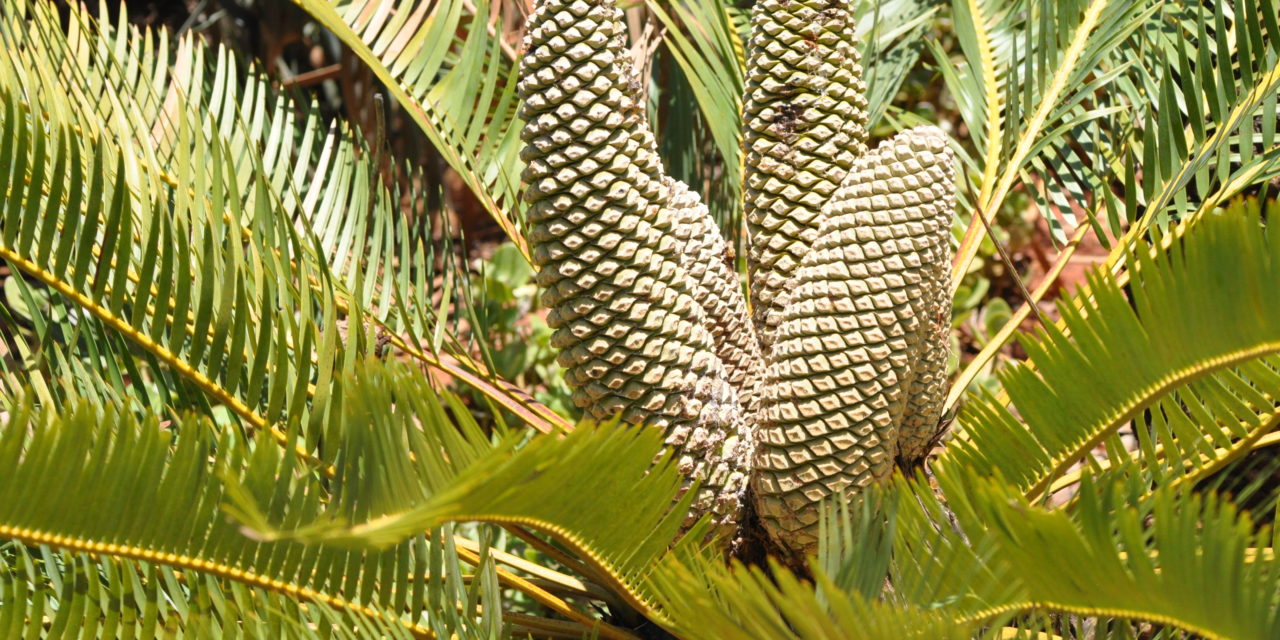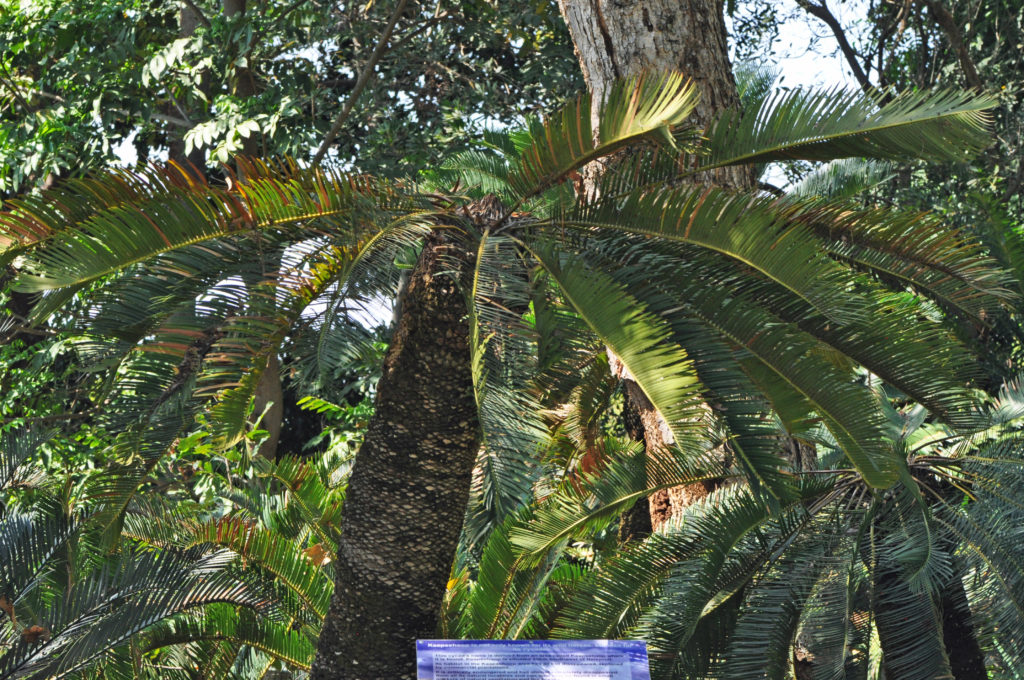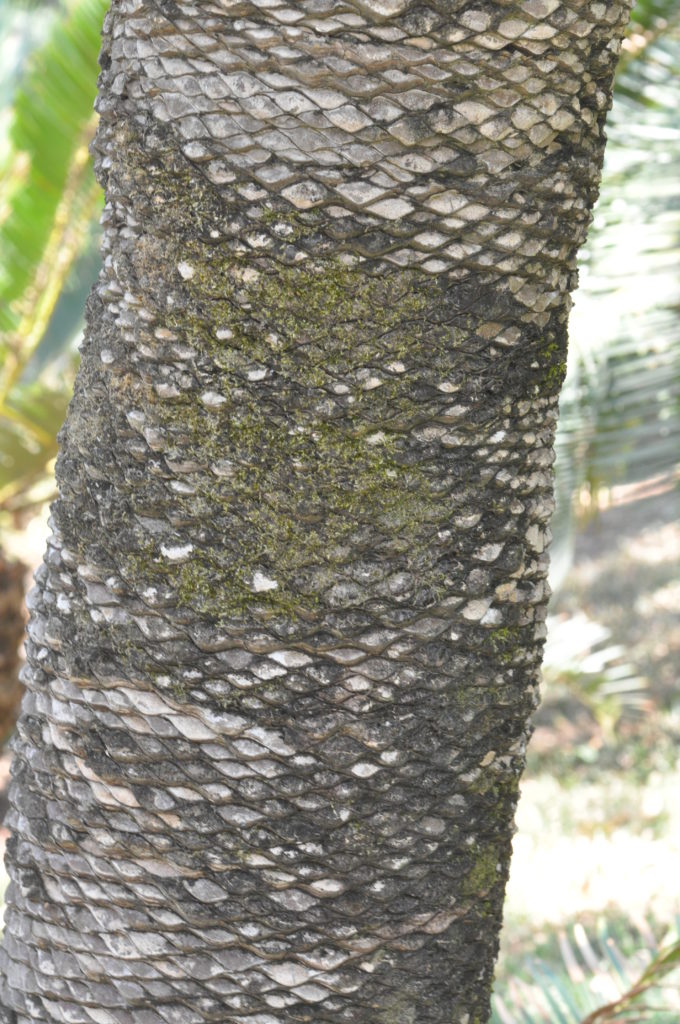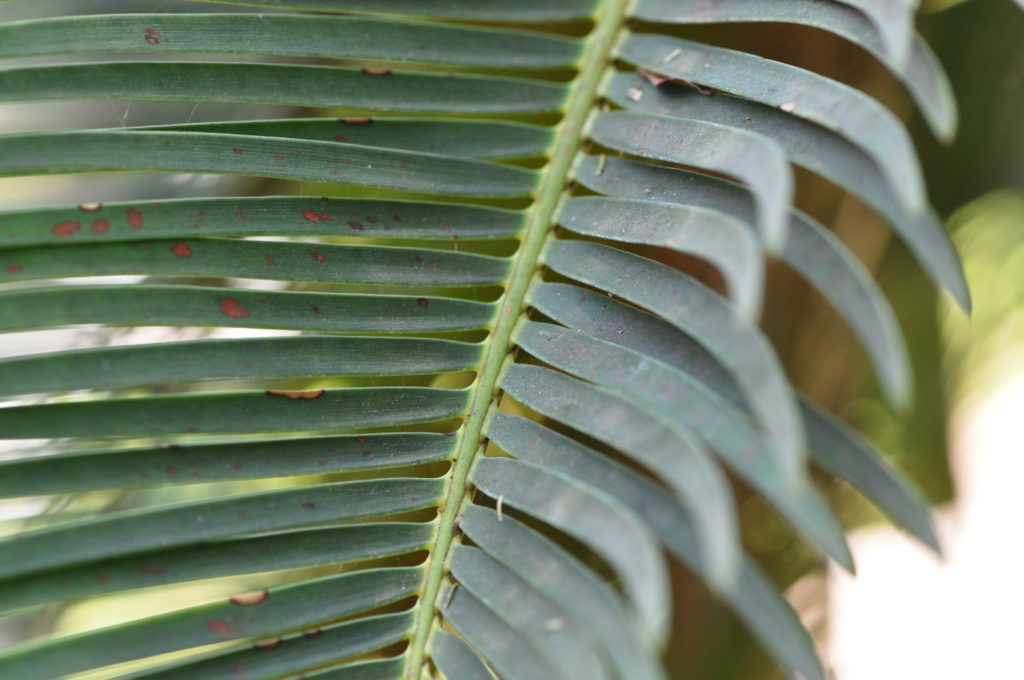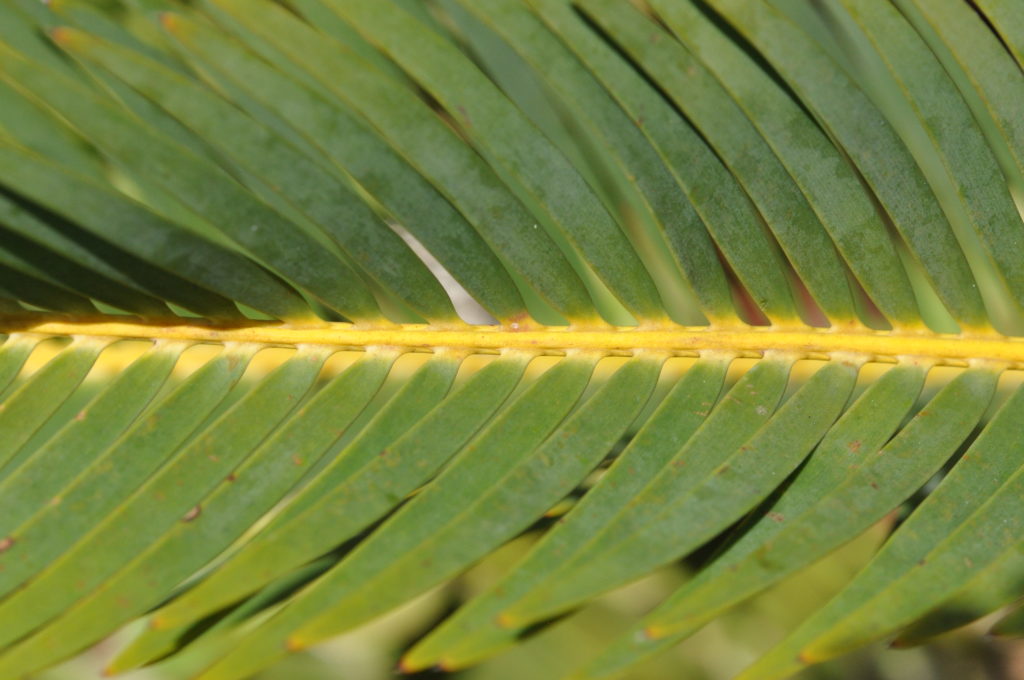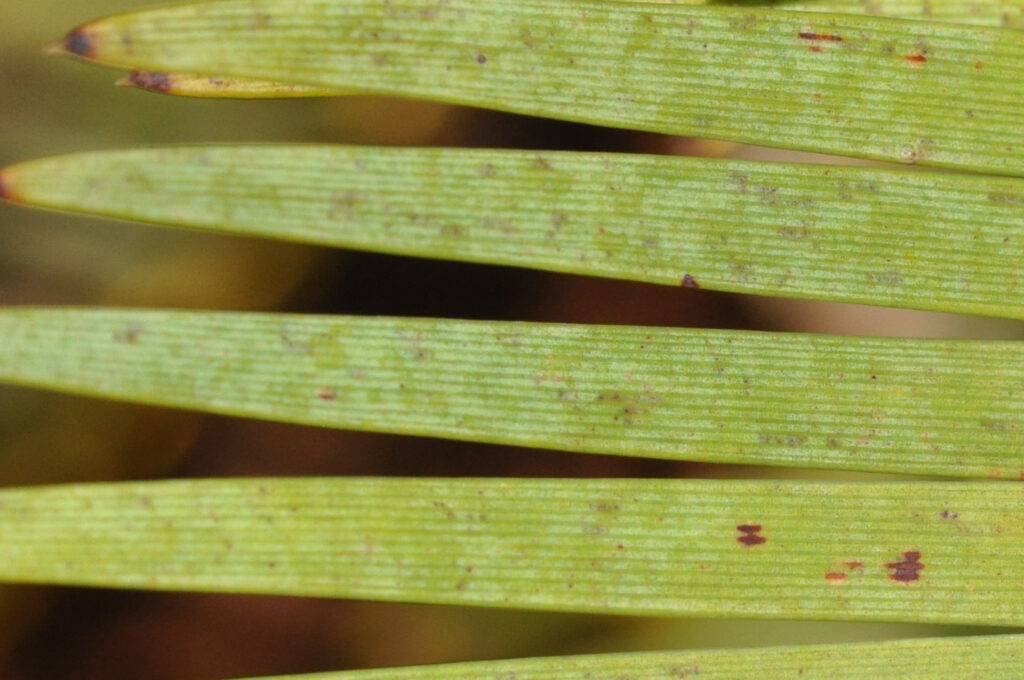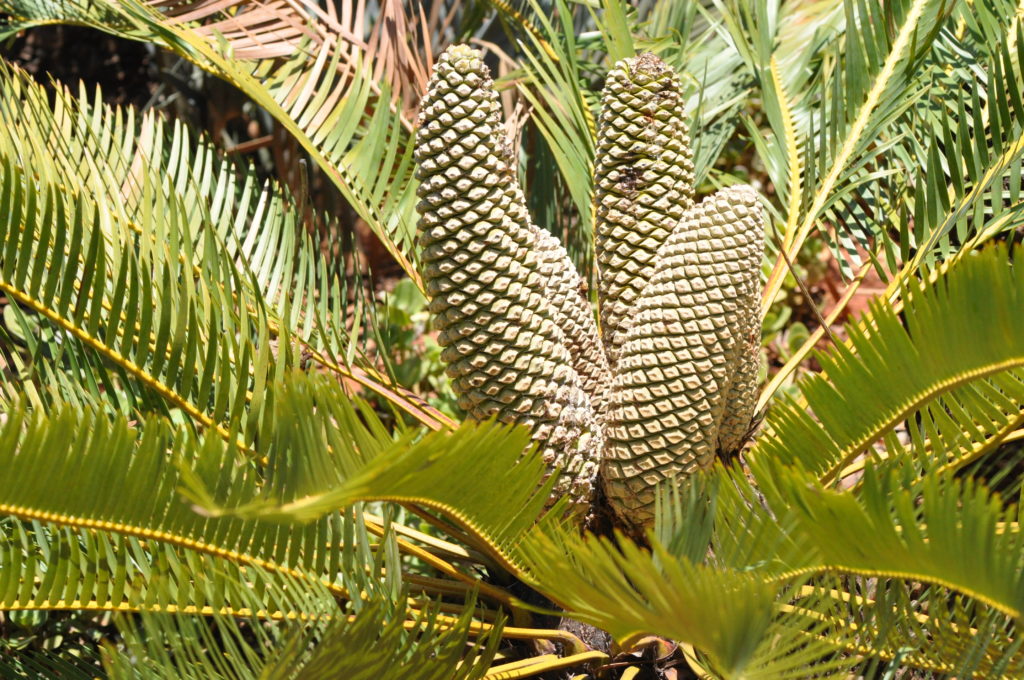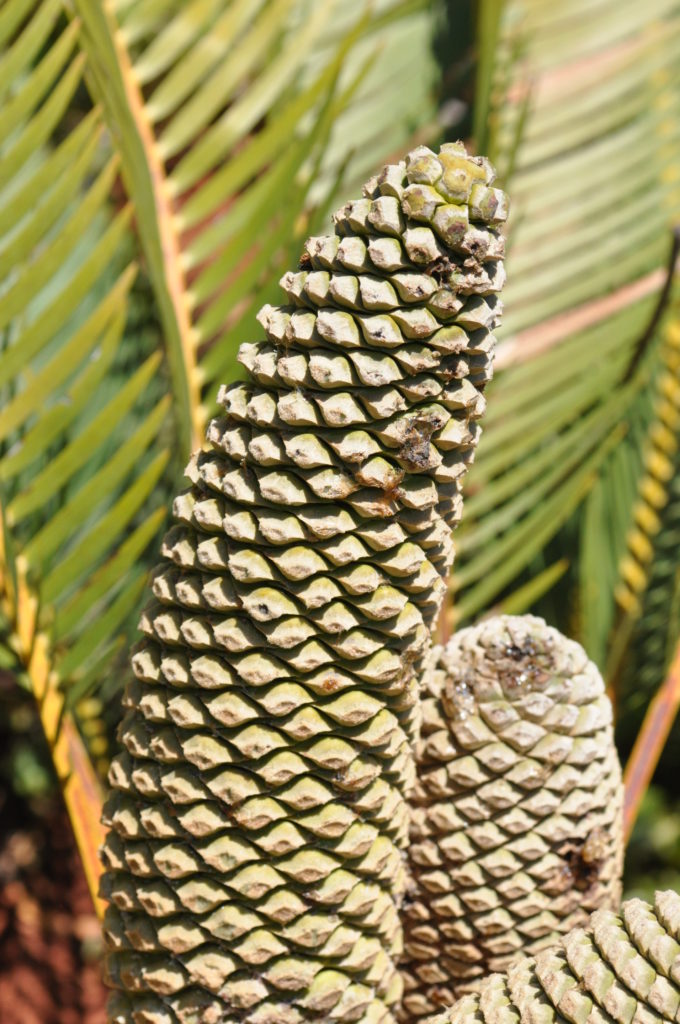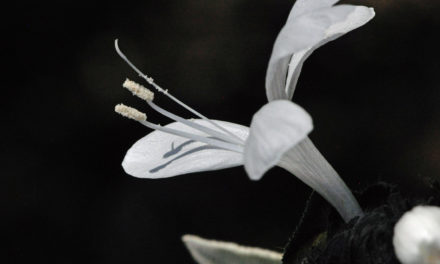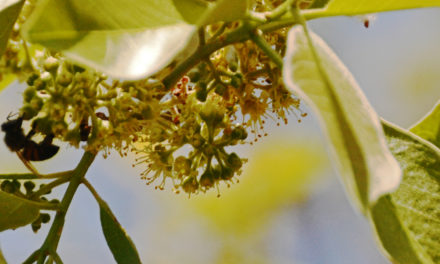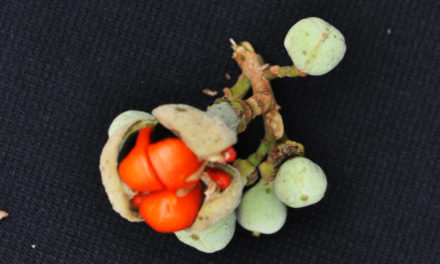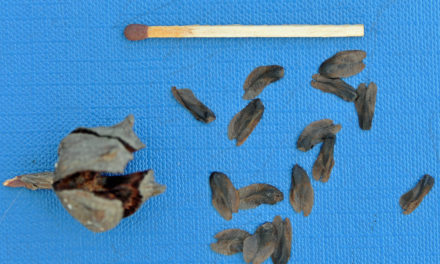General Info – summary
This endangered dioecious, occasionally reclining Tree may reach 4m high with a trunk up to 35cm wide. Fallen petioles leave marks on the trunk. Pinnately compound Leaves are long and narrow. Leaflets don’t overlap, have entire margins and are not reduced to spines near the leaf base. Male Cones are barrel-shaped with motile sperm and the shorter, wider Female Cones yield big orange-yellow seeds.
Description
Encephalartos laevifolius
SA Tree No. 6.
Common names: (Afr) Broodboom, Kaapsehoop-broodboom. (Eng) Cycad, Kaapsehoop Cycad. (siSwati) Sijekwane.
Common names: (Afr) Broodboom, Kaapsehoop-broodboom. (Eng) Cycad, Kaapsehoop Cycad. (Kaapsehoop is not in the Cape. It is a small town situated at the edge of the escarpment in Mpumalanga. The view from here, overlooking the lowveld, is worth seeing). (siSwati) Sijekwane.
Family: Zamiaceae. This family is part of the major group: Gymnosperms. They are usually cone-bearing plants producing naked seeds and include Ginkgo (in China), Cycads, Conifers (e.g., pine trees) and Gnetophytes: e.g., the unique Welwitschia mirabilis (tweeblaarkanniedood) are not wind pollinated and found in the deserts of western Namibia and southern Angola. Members of the gymnosperm family Zamiaceae have no flowers or fruit and the seeds are often contained in Cones. This family has 8 genera, including the Genus Encephalartos, which contains all species of cycads.
Name derivation: Encephalartos: within-head-bread: referring to the starchy bread that can be made from the pith of the inner trunk. laevifolius – smooth leaflets – without marginal spines. All cycads fall into the genus Encephalartos, which includes some of the most primitive living Gymnosperms. The gymnosperm family Zamiaceae has 9 genera including Encephalartos (cycads).
Species of Encephalartos (Cycads) are only superficially palm or fern like and are usually unbranched. The cycad tap Root is usually soon replaced by lateral roots, which become woody. Cycads have Coralloid Roots that contain symbiotic cyanobacteria (blue-green algae) that fix atmospheric nitrogen. Through a process of complex biological pathways, the cyanobacteria convert atmospheric molecular nitrogen into compounds such as ammonia, and amino acids needed by the cycads. They are unique Gymnosperms with evergreen, pinnately compound Leaves and only leaf scars eventually remain on the trunk once the leaves fall. Unlike other members of the family Zamiaceae, the cycads have leaflets that lack a central Midrib (vein). The hard leaflets do not bend easily and the sunken veins are parallel. Stomata (structure utilising 2 guard cells that, unlike lenticels, can control gaseous exchange) are present on the lower surface and may occur above. All species are dioecious with male and female Cones developing on separate plants. These cones develop in the centre of the leaf whorls. All species of cycads produce Motile Sperm, which do not move along a pollen tube. At maturity, Seeds are released when the Female cones disintegrate. All seeds produce carcinogenic and neurotoxic glycosides (cycasins). These are poisonous to mammals. The African plants in the genus Encephalartos include about 66 species and about 30 species occur in southern Africa.
Conservation: National Status: C E (Critically Endangered). 2009 (J.S. Donaldson). Apart from illegal collections, the plant cones are being attacked by a filamentous fusarium fungus, which can reduces seed viability. Alien vegetation invasion also hinders growth. Pine plantations have reduced the habitat. The tree is now extinct in Pondoland (Eastern Cape), KwaZulu-Natal and Limpopo. The population is decreasing.
Tree
Species of Encephalartos (Cycads) are only superficially palm or fern like and are usually unbranched. This Tree can grow to a height of 4m and has a relatively narrow trunk (to 35cm). Occasionally the Stem (main axis of the plant, the leaf and seed bearing as distinguished from the root-bearing axis) reclines with crowns growing upwards. Fallen leaves leave a distinct attachment mark (photo 2) on the trunk. The trunk may Sucker and branch from the base several times producing several trunks. The cycad tap Root is usually soon replaced by lateral roots, which become woody. Cycads have Coralloid Roots that contain symbiotic cyanobacteria (blue-green algae) that fix atmospheric nitrogen. Through a process of complex biological pathways, the cyanobacteria convert atmospheric nitrogen into compounds such as ammonia, and amino acids needed by the cycads.
- Photo 1: David Becking.
- Photo 2: David Becking.
Leaves
Cycads are unique Gymnosperms with pinnately compound Leaves (leaflets arranged along either side of the leaf rachis, the central stalk, like a feather). These leaves develop near the stem apex and, in this plant; the crown has comparatively little wool. These leaves may exceed 1m in length. Old leaves are almost horizontal with their ends pointing downwards. The greenish (photo 3) to yellow Rachis (main axis bearing leaflets – photo 5) may be slightly twisted near the apex. The generally straight leaves curve slightly downwards and may have a greyish bloom when young. Unlike other members of the family Zamiaceae, the cycads have Leaflets that lack a central Midrib, and each leaf apex is spine tipped. The central leaflets are the largest – up to 140 x 7mm and those at the base of the leaf are reduced, but not to spines.
The under-surface of the narrow, leathery and bluish green Leaflets have as many as 12 visible parallel Veins (photo 6 – here a hand lens will help). Stomata (structure utilising 2 guard cells that, unlike lenticels, can control gaseous exchange) are present. These require a microscope to study. Only in young leaflets is the upper surface woolly. The leaflets are situated close together but do not overlap (photo 4). The leaflet Margin is entire (with a continuous margin, not in any way indented – photo 4). The yellow Petiole (leaf stalk) is up to 25cm long. Cataphylls (rudimentary scale-like leaves, are clearly visible at the apex of the almost hairless trunk. The aging leaf blade falls first and later the entire petiole falls – leaving only a permanent scar on the stem.
- Photo 3: David Becking.
- Photo 4: David Becking.
- Photo 5: David Becking.
- Photo 6: David Becking.
Cones
Gymnosperms have unenclosed or naked seeds. They have no flowers or fruit and the seeds are often contained in cones. In the Angiosperms (flowering plants), the seeds are enclosed in an ovary. In the Gymnosperms, there are 2 modes of fertilization. In all the Cycads (including Encephalartos) and the single extant (not extinct) species of Ginkgo biloba, the male cones produce motile sperms and which do not move along a pollen tube, whereas the remaining members of the Gymnosperms all have non-motile sperm with no flagella and are moved along a pollen tube to the egg.
In Encephalartos laevifolius, the only slightly woolly Cones appear on short stalks in the centre of the leaf whorls. Like all cycads, this tree is Dioecious having male and female Cones that develop on separate plants. The more or less cylindrical Male Cones are each up to 43 x 11cm and up to 5 male cones may appear on each trunk. These cones produce motile sperm from (Sep-Nov). Up to 4 thinly woody, barrel-shaped, Female Cones are each is up to 30 x 13cm and each cone can produce in excess of 200 orange-yellow Seeds that are up to 2,7 x 2,3cm. At maturity, these Seeds are only released when the Female cones disintegrate.
- Photo: David Becking.
- Photo: David Becking.
Distribution & Ecology
These plants are often found on south-facing hills, in full sun or in well-drained aerated soils and in summer rainfall areas that receive more than 1 000mm of annual rain. They occur naturally in mist-belt grasslands from about 900m to 1 300m high. They are Located in Mpumalanga e.g., on the highveld escarpment of the Drakensberg mountains near the village of Kaapsehoop (not in the Cape Province). These trees also occur further north along the Drakensberg in the Pilgrims Rest area. They occur in SW Limpopo, NW of Swaziland – near the Havelock Mine, and on the NE boarder of the Eastern Cape. They are thus Endemic (restricted to a particular geographic location) in southern Africa. The trees are associated with rocky quartzite ridges (quartzite: rock composed almost entirely of quartz. It is non-foliated and usually forms from the metamorphism of sandstone). Insects are responsible for pollination. By consuming the fleshy part the bats, birds, rodents, and monkeys are responsible for Seed dispersal.
Ethnobotany
This frost hardy Plant is also drought resistant. It is slow growing and does best in moderately sunny positions and in a summer rainfall area. Prior to planting, fresh seeds should be cleaned, stored for up to 6 months then soaked in water then any that float should be discarded. All cycad seeds produce carcinogenic and neurotoxic glycosides (cycasins). These are poisonous to mammals – including man. It is advisable to wear gloves when handling the poisonous seeds.
References
Boon, R. 2010. Pooley’s Trees of eastern South Africa. Flora and Fauna Publications Trust, Durban.
Coates Palgrave, M. 2002. Keith Coates Palgrave Trees of Southern Africa. edn 3. Struik, Cape Town.
Donaldson, J.S. 2009. Encephalartos laevifolius Stapf & Burtt Davy. National Assessment: Red List of South African Plants version 2020.1. Accessed on 2023/04/06.
Lawrence, G. H. M, 1951. Taxonomy of Vascular Plants. The Macmillan Company, New York. Tenth Printing 1965.
Palmer, E. & Pitman, N. 1972. Trees of southern Africa. Balkema, Amsterdam, Cape Town.
Schmidt, S. Lotter, M. & McCleland, W. 2002. Trees and Shrubs of Mpumalanga and the Kruger National Park.
http://plantzafrica.com/plantefg/voteplant.php
http://www.iucnredlist.org/details/41891/0
http://cycadsociety.org/?page_id=1800
http://biodiversityadvisor.sanbi.org/wp-content/uploads/sanbi-identify-it/plants/encephalartos.htm
http://www.theplantlist.org/browse/G/Zamiaceae/
https://www.diffen.com/difference/Angiosperms_vs_Gymnosperms

